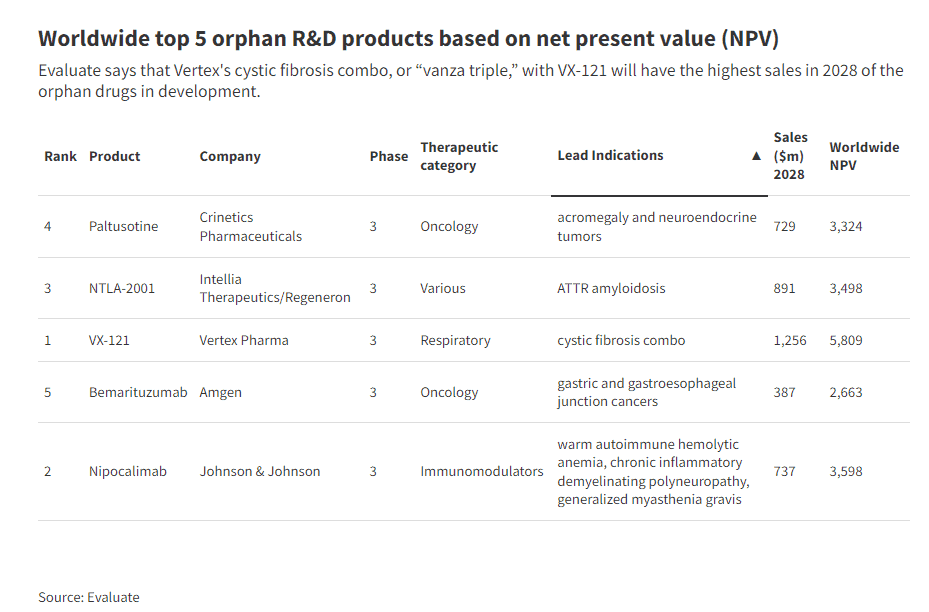Vertex’s cystic fibrosis triple combo is poised to become the top-selling orphan drug in terms of net present value, amid shifting sentiments in the pharma industry for rare disease drugs, according to Evaluate.
VX-121, or the “vanza triple,” which combines a new molecule called vanzacaftor with Vertex’s already approved CF meds tezacaftor and deutivacaftor, now heads up Evaluate’s new list of orphan drugs expected to be at the top in four years’ time. The med has a net present value of $5.8 billion, with $1.26 billion in sales expected by 2028.
Sales for the triple will eat into Vertex’s own market share with the CF drug Trikafta, which is listed as the second-most valuable orphan in 2028 for approved meds with sales that could top $6 billion in that year. But Vertex can expect some savings, as the triple has fewer royalty payouts attached, according to Evaluate.
Vertex has only just nabbed the coveted title after Merck & Co.’s sotatercept was approved, removing it from the pipeline section of Evaluate’s annual ranking. That drug had a net present value of $9 billion and is now known as Winrevair. The drug did not make the approved orphan drug list with a projected $2 billion in sales for 2028. However, Merck has a few more indications up its sleeve that could boost those expectations with additional approvals down the line.

Behind Vertex is Johnson & Johnson’s nipocalimab, which the company refers to as a “pipeline in a product.” The drug just got an orphan drug tag in fetal and neonatal alloimmune thrombocytopenia (FNAIT), but that’s not the indication that helped land it in the number 2 slot on the pipeline list. Evaluate instead cited its more advanced indication, myasthenia gravis, a market that is growing ever more crowded. Nipocalimab’s net present value is $3.60 billion with predicted 2028 sales of $737 million.
Gene editing biotech Intellia Therapeutics snagged the third position with a net present value of $3.50 billion and sales of $891 million for 2028, which will be shared with partner Regeneron. If approved, Intellia would be the first company to have a drug approved that edits the cell’s genome within the body.
Late last year, CRISPR Therapeutics and Vertex earned approval for Casgevy in sickle cell disease. The treatment uses CRISPR-Cas9 to edit stem cells outside the body and then put them back in to express the fetal version of hemoglobin. So it was the first gene editing approval, but a slightly different modality than what Intellia and Regeneron are going for.
Cancer drugs from Crinetics and Amgen take the final two slots on the list.
Also falling off the list this year due to approval was Sarepta’s gene therapy Elevidys, which was controversially granted accelerated approval last year in certain patients with Duchenne’s muscular dystrophy.
Overall, orphan drugs are expected to bring in $185 billion in sales this year, rising to $270 billion by 2028, according to Evaluate. But growth in orphan drug sales is expected to slow into the single digits after averaging 11% growth for the 10 years leading up to 2023. Evaluate blames this deceleration on the “blazing return” of huge drugs in major diseases. Read: obesity.
“Obesity has captured the most attention, but emergent blockbusters across immunology and neurology are also drawing in R&D dollars as Big Pharma look to plug patent expiry holes,” the report said.
Another major interest is neuroscience where major breakthroughs have occurred, and huge deals are being made to capture the biotechs working in the space. Bristol Myers Squibb bought Karuna Therapeutics and its schizophrenia med KarXT for $14 billion while AbbVie picked up Cerevel for $8.7 billion, all at the end of 2023.

